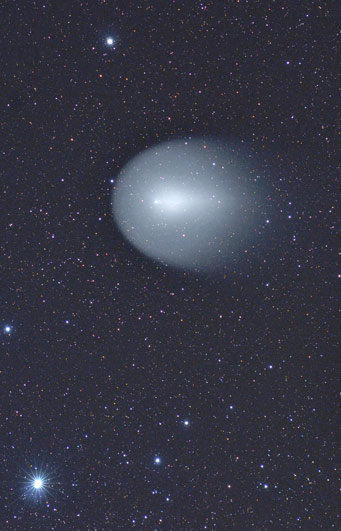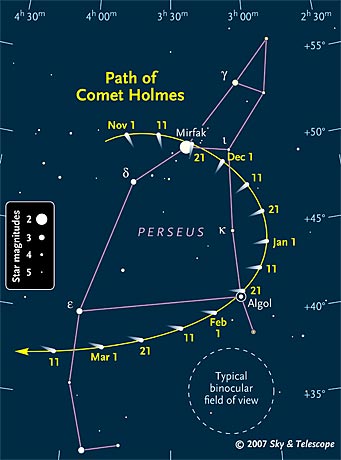
Observers anxiously awaited moonless skies to again see Comet Holmes in all its splendor. North Carolina photographer Johnny Horne captured this view before moonrise on November 27th. The field is 3° tall, with north to the left and bright Mirfak (Alpha Persei) at bottom left. Click image for larger view.
This may also be the first published astronomical shot taken with Nikon's new D300 DSLR camera. It's a single 5-minute exposure made using in-camera noise reduction and a 300-mm f/2.8 lens set at f/4. The camera offers "live focus" and a CMOS detector, both of which have proven track records for astronomical photography. (The image has been processed slightly in Photoshop to darken the sky a bit.)
Image by Johnny Horne
Update Dec. 11: The bright, glowing blob that many people saw last night — and some mistook for a comet — was a fuel dump from an US Atlas Centaur rocket that had just launched a spy satellite. Details.
----------------------
Did I say a few days ago that Comet Holmes had become invisible to the naked eye? That was then; now it’s back.
The difference isn’t in the comet. It’s that the Moon has just left the early-evening sky, allowing a dark view for the first time in nearly two weeks.
Around 7 last night (November 27th), I stepped out my front door in Boston’s moderately light-polluted outer suburbs, looked up, and there it was again — a sizeable puffglow just above Alpha Persei (Mirfak). Not only is the moonlight gone, but now the comet is separated enough from Alpha Per that the star’s 2nd-magnitude glare doesn’t get in the way.
Binoculars actually gave a prettier view than my 12.5-inch reflector — framing the big, parabola-shaped comet head (a good 0.7° wide, I estimated) next to the gorgeous starry field of the Alpha Persei Association. Inside the head was the familiar largish glow behind the (invisible) nucleus and the broad “spine” that’s now extending behind the glow. The 12.5-inch at 75× showed these features hardly any better, so big are they now, and the whole thing overfilled the telescope’s view.
I’ve long thought that moonlight and light pollution differ in how badly the same amount of them hinder astronomical views, with light pollution being the worst. But I may have to revise that notion considering the experience of my S&T colleague Tony Flanders observing the comet last evening from a badly light-polluted inner suburb of Boston. Here’s what he says:
“I got my best naked-eye view of Comet Holmes to date. When the comet first exploded in October, it was extremely bright but nearly stellar. Later on, it got tangled with Alpha Persei and the surrounding group of bright stars. And when the full Moon was nearby, I couldn’t see the comet at all without binoculars.
“But now it’s much easier to spot naked-eye than any deep-sky objects except the Pleiades. It’s big enough so that nobody could mistake it for a star, and it appears significantly brighter than the Andromeda Galaxy or the Double Cluster.

Northern Hemisphere observers can find Comet Holmes in Perseus during evening for months to come. Click on image for a larger view.
Sky & Telescope
“My most detailed view was through my 70-mm refractor at 20×. The outer coma was pretty vague in the suburban skyglow, but I could trace it to a diameter of roughly 45′. Inside that was a brighter ellipse about 10′ by 25′. The southeast end of the ellipse was quite intense, and it faded out gradually to the northwest.”
So, is moonlight gentler or tougher on deep-sky observing than the same amount of light pollution? What do you think? Add to the comments below.
P. S.: I can think of two possible reasons for a difference between their effects:
Color. A light-polluted sky has the peach-orange tint of high-pressure-sodium lamps (though it’s been turning whiter in the last decade with the spread of metal-halide lamps). A moonlit sky, on the other hand, is blue — exactly as blue as a daytime sunlit sky, as long-exposure photos show (try it). We don’t see this because our color vision doesn’t work well in dim light, but it might affect the visibility of faint things even so.
Altitude. Moonlight comes from the top down, illuminating the upper atmosphere as much as the lower atmosphere. Light pollution comes from the bottom up. Much of it spreads out from limited areas (cities), and the worst of it consists of near-horizontal rays; these characteristics mean that it illuminates the lower atmosphere more than the upper.
 8
8









Comments
Tony Flanders
November 28, 2007 at 1:33 pm
I can't say whether moonlight is more or less harmful than "the same amount" of artificial light pollution unless you define "the same amount." I'd define it as the amount that has the same effect on deep-sky observing, which reduces the whole question to a tautology.
I explored the question in some detail in my blog at How Brightly Shines the Moon?. Taking the sky as a whole, a full Moon is quite a lot less injurious than the light pollution at my home in Cambridge, and somewhat less injurious than the light pollution in Arlington, where I observed Comet Holmes.
However, it's a whole 'nother story right around the Moon. The reason that this full Moon hurt Comet Holmes so much was that it was just 25° away. (Another way of saying the same thing is that the comet is nearly opposite the Sun.) At that distance, the sky is brighter than in any but the very worst artificial light pollution. Even so, I had no trouble at all seeing the comet through my 10x30 binoculars just 4 hours before the Moon was officially full.
You must be logged in to post a comment.
Alan MacRobert
November 28, 2007 at 2:54 pm
> I can't say whether moonlight is more or less
> harmful than "the same amount" of artificial
> light pollution unless you define "the same
> amount."
What I mean is the same surface brightness of the sky. That is, you look up and see the sky glowing with such-and-such a brightness, regardless of what stars and deep-sky objects you can detect. Like you'd measure with a light meter.
You must be logged in to post a comment.
Zubenelgenubi
November 28, 2007 at 5:35 pm
Moonlight is more harmful. I can't see Ursa Major that well when there is a full moon, but I can see it in light polluted cities.
You must be logged in to post a comment.
Roy Robinson
November 28, 2007 at 6:08 pm
"So, is moonlight gentler or tougher on deep-sky observing than the same amount of light pollution? What do you think?"
Alan's comment about the color difference between moonlight and light pollution hadn't occurred to me, so thanks for that. But, to answer the question:
1. Moonlight bothers us only half the time. Light pollution is a constant.
2. We might just be able to do something about light pollution if we only try hard enough.
So, light pollution is the "winner."
You must be logged in to post a comment.
john mccormick
November 30, 2007 at 6:34 pm
Nov 30. Between clouds I was easily able to walk outside from a brightly lit room and see Holmes this evening in Central PA naked eye (Punxsutawney, hill top, little light pollution).
The view through very cheap 20X60mm binoculars was very clear.
Not really much different with a 2-inch 42mm eyepiece on a 12-inch Dob reflector but great view. 8mm 2-inch eyepiece didn't show much more.
Thought it might be even better with an Orion UltraBlock filter but the contrast wasn’t as good.
Clouds rolled in before I could setup for a photograph or try other filters.
You must be logged in to post a comment.
Jon Collman
December 6, 2007 at 8:12 pm
I'm inclined to agree with Roy Robinson in a general sense - artificial LP is vastly worse because it is a constant. However, if one is using only one instance of comparison then I think that the "top-down-effect" of moonlight has a more profound effect on contrast and therefore visibility of faint deep sky objects. I can counter to some extent the effects of artificial LP with filters & barlows that have no effect on moonlight pollution.
I can also live easier with moonlight as it's natural and not another by-product of "civilization", AND there's not a heck of a lot we can do about the moon anyhow....
You must be logged in to post a comment.
Eduardo Casarin
December 7, 2007 at 11:44 pm
I Thank you very much all this info but could I have a more up to date we are in December and it appears that youre dates are from November I am mistaken ? could you verify this for me Thanks again and Congrats for a job well done
You must be logged in to post a comment.
Ed Pischedda
December 8, 2007 at 12:17 am
17P/Holmes looking rather faint through 7x50 binoculars here in suburban north central Texas on a moonless windy night - not anything you'd notice with the naked eye, unlike the nearby Pleiades, which catch your attention out of the corner of your eye after giving your eyes 10 minutes or so to adjust to the darkness. But you can find it if you search: look high to the NNW, and assuming you can identify Mirfak and Algol, draw a mental line between those two stars, then look back along it from Mirfak toward Algol about 1/3 of the way and a little below - you should find it there looking like a diffuse hazy smudge, not any brighter than any high cirrus cloud that might drift into your view. With Mirfak in the upper right of your binocular field of view (with what I call a "leaning barn" asterism around it), 17P/Holmes is visible in that same field - try waving the binoculars back and forth a little if you must - the comet should then get your attention a little below and to the left of your field of vision. Then again you may just prefer to go to bed - the comet isn't all that impressive anymore.
Hope this helps - happy comet hunting.
You must be logged in to post a comment.
You must be logged in to post a comment.